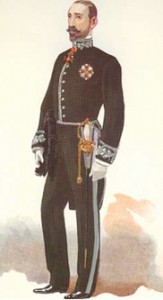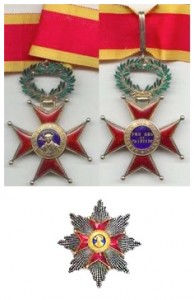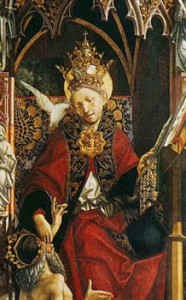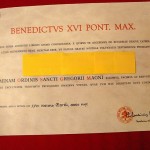From time to time, there will appear notices in the Tidings that the Pope has awarded some notable Catholic Angeleno or other the Order of St. Gregory. If the person is of sufficient note in the world at large — such as Rupert Murdoch or Bob Hope — the secular papers will mention it as well. References to “Papal Knight” often comes up in biographies of the great or the good, whether living or dead, and on rare formal occasions an individual will be seen wearing a medal made up of a red Maltese Cross with a blue and gold seal in the center. On even rarer church occasions, men be seen in greenish tail-coats with a matching plumed hat, reminiscent in shape of that worn by the Knights of Columbus. But just what is this Order of St. Gregory?
It is easier, at first, to say what it is not. It is neither an ancient military order given up to charitable pursuits, like those of Malta and the Holy Sepulcher; nor is it a fraternal organization, like the Knights of Columbus or Peter Claver. Rather, it is a Papal decoration awarded — usually, though not always, at the request of the local bishop — to an individual for service to the Church by the Pope in his capacity as a temporal ruler: the monarch of the Vatican City State. As sovereign entity, in addition to diplomats, soldiers, coins, and stamps, the Holy See has its own honors system, of which the Order of St. Gregory is an integral part. As with most such orders granted by monarchs and republics across the globe, there is no corporate life to the institution, save the wearing of insignia and uniforms by the members on appropriate occasions (the American Military’s Legion of Merit, for example, while bringing an impressive breast badge, has no dues, meetings, or corporate charitable work). However, certain countries and dioceses (such as Los Angeles) do have associations for all holders of Papal decorations that do engage in something of this sort. But these are local initiatives, and membership in these organizations is purely voluntary for Papal honorees.There are on paper five Papal Orders today. But the two highest — the Orders of Christ and the Golden Spur (Golden Militia) have since Paul VI’s time been reserved to heads of state. Although both are possessed of fascinating histories rooted in Medieval history, neither has any living members.
The three that are still awarded are of much more recent date, stemming from the mid-19th century when the age-old Papal States were fighting for their life against enemies within Italy and abroad. At that perilous time, the Popes felt the need to reward both their own subjects and the foreigners who flocked to defend them — most notably in the military unit called the Papal Zouaves. After the fall of Rome in 1870, service to the Holy See, when the Pope was the “Prisoner of the Vatican” meant both the sacrifice of civic careers for the “Black Nobility” who remained loyal to him, and strenuous financial or other efforts for foreigners who either supported the Holy See overseas or came to the Vatican to help out in various capacities. For such as these, knighthoods were one of the few ways successive Popes could show their appreciation. At last, after the relationship of the Vatican with the Kingdom of Italy was regularized by the Lateran Treaty in 1929, the Papal Orders of Knighthood became what they are today — a way for the Pope or local Bishops to show their appreciation of those who assist the Church in extraordinary ways.The highest remaining order in the Papal system is that of Pius IX, which in its various grades is generally given to heads of state, ambassadors to the Holy See, and to prominent Catholics who have done rather extraordinary things for the Church. The Order of St. Sylvester is given to those who help the apostolate, especially in arts and letters. It is rarely given out to Americans, although it is not uncommon for the Maronite bishops in this country to recommend it.
In between, and most common, is the Order of St. Gregory the Great. Originally founded by Pope Gregory XVI in 1831, it had four classes: Knights Grand Cross (1st class), Knights Grand Cross (2nd class), Knights Commander, and Knights, in military and civil divisions. Its motto was and is Pro Deo et Principe (“For God and Prince”), reflecting the Pope’s temporal role; three years later the Pontiff issued another decree clarifying the uniform and insignia. One of the more interesting aspects of the order was its civil and military classes, the last of which might require some explanation for modern readers.
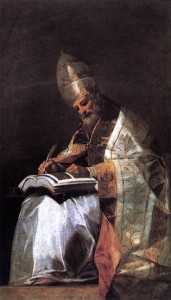
GOYA Y LUCIENTES, Francisco de, St Gregory the Great, c. 1797, Oil on canvas, 188 x 113 cm, Museo Romántico, Madrid
Rule of the Papal States, which the repeated experience of various Monarchs attempting to reduce the Pope from leader of the Universal Church to a court chaplain showed was necessary, required the Papacy to enter the areas of diplomacy and war. In addition to the medieval orders earlier mentioned, the Holy See early on devised methods of showing gratitude to princes and soldiers who defended either or both the Papal States and the Catholic Faith. One was sending a “Golden Rose.” Another was granting a title of Papal Nobility (long time Angelenos will remember Carrie Estelle Countess Doheny, while music lovers still revere Pontifical court. Yet another honor was to be made one of the various ranks of Papal Chamberlain (under Paul VI their distinctive dress and ranks were abolished, and rolled into the single body of Papal Gentlemen).
Soldiers might be rewarded as well with the title Athleta Christi Nobilis ( “Athlete of Christ”), or, if a Captain was to move against the enemies of the Holy See, he would be named “Gonfalonier of the Roman Church,” and entrusted with the Gonfalone when he set out. A similar title was “Captain General of the Church.”
But one of the most moving signs of Papal favor toward military bravery took place at the Vatican every Christmas Eve at least the 14th century until 1877. Servant of God Dom Prosper Gueranger (restorer of Gregorian Chant and founder of the Liturgical Movement, whose cause for Beatification has been opened at Rome) describes this recognition in his Liturgical Year (Vol. II, “Christmas,” Bk. 1, p. 126):
The Sovereign Pontiff, the Vicar of our Emmanuel, blesses, in his name, a Sword and Helmet [Stocco and Cappello], which are to be sent to some Catholic warrior who has deserved well of the Christian world. In a letter addressed to Queen Mary of England and to Philip, her husband, Cardinal Pole gives an explanation of this solemn rite. The sword is sent to some Prince, whom the Vicar of Christ wishes to honour in the name of Jesus, who is King: for the Angel said to Mary: The Lord will give unto him the Throne of David his father. It is from him alone that the power of the sword comes; for God said to Cyrus: I have girded thee (with the sword); and the Psalmist thus speaks to the Christ of God: Gird thy Sword upon thy thigh, O thou most Mighty! And because the Sword should not be drawn save in the cause of justice, it is for that reason that a Sword is blessed on this Night, in the midst of which rises, born unto us, the divine Sun of Justice. On the Helmet, which is both the ornament and protection of the head, there is worked, in pearls, the Dove, which is the emblem of the Holy Ghost; and this to teach him who wears it that it is not from passion or ambition that he must use his sword, but solely under the guidance of the divine Spirit, and from a motive of spreading the Kingdom of Christ.
Commenting on this ceremony, the saintly abbot declares, “How beautiful is this union of energy and meekness under the one symbol and ceremony! This power of blending and harmonizing the varied beauty of distinct classes of truth is not to be found save in that Christian Rome, which is our Mother and where God has established the centre of Light and Love. The ceremony we have been describing is still observed. What a grand list it would be, had we the names of all those glorious Christian Warriors, who were thus created Knights of the Church, at this solemn hour, when we celebrate the Birth of him who came to vanquish our enemy!” (loc .cit). Fortunately, we have such a list. Some of the swords so blessed were retained by their recipients and treasured by their descendants. The swords so blessed by Julius II to James IV of Scotland became the Sword of State, and is one of the Scottish Crown Jewels kept at Edinburgh Castle. Similarly, the sword sent by Alexander VI in 1460 to Albert II “Achilles,” the Elector of Brandenburg, found its way into the Prussian Crown Jewels, usually displayed at Berlin’s Charlottenburg Palace. It is ironic that these Papal gifts became major symbols of sovereignty Europe’s two foremost Protestant monarchs.
In any case, during the decade of the ultimate successful war against the Papal States by the nascent Italian government, Pius IX found himself deserted by the Catholic governments of Europe. At Christmas of 1864, when his War Minister, Msgr. de Merode presented some of the volunteers who had come from all over the world to join the small Papal army, Pius, showing them the sword he had just blessed, replied “I keep this sword, for there is not a single Christian Sovereign to whom I can send it. I look everywhere around me, and I see no army in the world drawing its sword for justice and the right, saving yourselves. You only, a feeble remnant, gathered round your Sovereign, serve a just cause, for you bear the sword to defend Truth and the Right. Be proud of this fact. I say once more, in the wide world you are the only ones!” (Frederick Francis Xavier de Mérode: minister and almoner to Pius IX , Mgr. François-Nicolas-Xavier-Louis Besson, Mary Elizabeth Baroness Herbert, p. 199). Fittingly, Pius IX performed the blessing for the last time 13 years later, giving the cap and sword to General Hermann Kanzler, final commander of the Papal Army.
It was during that sad period, however, that the Order of St. Gregory came into its own. Always outgunned and outmanned, the Papal Army, spearheaded by the Zouaves, rushed from one encounter to another, facing invasion from without and subversion from within with piety, gallantry, and good humor. At such engagements as the defeat of Castelfidardo, the siege of Ancona, the glorious victory of Mentana, and the tragic end at the Porta Pia, the Pope’s soldiers won a seemingly endless round of medals of St. Gregory in its various grades. The list goes on and on — the convert Englishman John Kenyon of Gillingham Hall in Suffolk, who went on to be a Justice of the Peace in his native land and was a benefactor of Downside Abbey, started a local parish, and became a Papal Chamberlain; the American Charles Tracey, born in Albany, who became a general in the New York militia and was repeatedly re-elected to Congress; the French-Canadian Joseph Dumont, who went on to serve in the House of Commons in Ottawa; and on and on. One very notable Irish American recipient was Captain Myles Keogh; after his death at the Little Bighorn (he was Custer’s second in command) his body was spared mutilation by the Indians due to the presence of the St. Gregory and another Papal medal of valor — won for his bravery at the Siege of Ancona — on his body.
With the war over, successive Popes continued to award the order to pious Catholics — albeit to folk whose service to the Church was or a more peaceful nature. Nevertheless, it is a proud roster, numbering Roy E. Disney, Ricardo Montalbán, Paul Salamunovich, Roger Wagner, and many other prominent Angelenos past and present in its ranks. Multiply that by the entire Catholic world and the amount of talent symbolized by the medal of the Order is overwhelming.
There have been changes to the St. Gregory in the 20th century. In 1905, Pope St. Pius reorganized the rank structure, and in 1994, although women were not admissible to the Order under its statues, Los Angeles’ Roger Cardinal Mahony nominated the first Ladies of St. Gregory. As the Roman authorities did not block the move, the law was altered de facto and many more have been appointed since across the globe. The only privilege that the order carries, other than the title and the uniforn, is the right to ride a horse through St. Peter’s Basilica — though it is a long time since that has been exercise, if ever it was.
It is a very proud heritage indeed that the holders of the Order and the other Papal knighthoods and honors (such as the Pro Ecclesia et Pontifice and Benemerenti medals) carry on. Moreover, these folk are a living reminder of the intimate link which unites local Catholics with the oldest throne in Europe and the holiest in the world. The people of the Archdiocese of Los Angeles may be very honored indeed that they have produced so many of them.
Holy See
http://www.vatican.va/
Vatican City State
http://www.vaticanstate.va/EN/homepage.htm
Gentlemen of His Holiness
http://de.wikipedia.org/wiki/Gentiluomo_di_Sua_Santit%C3%A0
Addetti di Anticamera
http://www.parafrenieri.it/home.asp
Swiss Guard
http://www.schweizergarde.va/home.html
Saints Peter and Paul Association
http://www.associazionesspietroepaolo.it/
Circolo San Pietro
http://www.circolosanpietro.info/joomla/
Vatican Heraldry
http://www.araldicavaticana.com/
PAPAL HONORS
Reunion de la Noblesse Pontificale
http://fr.wikipedia.org/wiki/Noblesse_pontificale
States of the Church and Nobility
http://www.cnicg.net/pdf/spscn.pdf
Papal Honors
http://en.wikipedia.org/wiki/Papal_Orders_of_Chivalry
History of the Papal Orders of Chivalry by Guy Stair Sainty
http://www.chivalricorders.org/vatican/papal.htm
Supreme Order of Christ by Guy Stair Sainty
http://www.chivalricorders.org/vatican/christ.htm
Supreme Order of Christ
http://en.wikipedia.org/wiki/Supreme_Order_of_Christ
Order of the Golden Spur
http://en.wikipedia.org/wiki/Order_of_Pius_IX
Order of St. Gregory the Great by Guy Stair Sainty
http://www.chivalricorders.org/vatican/gregory.htm
Order of St. Sylvester
http://www.papalknights.org.uk/
Chevaliers Pontificaux of France
http://www.oeuvres-uof.org/chevpontif/index.htm
National Association of Papal Honorees in the United States
http://www.oeuvres-uof.org/chevpontif/index.htm
Papal Honors in the Archdiocese of Baltimore
http://www.archbalt.org/about-us/affiliates/papal-honors.cfm
Papal Honors in the Archdiocese of Atlanta
http://www.archatl.com/clife/papalhonors.htm
